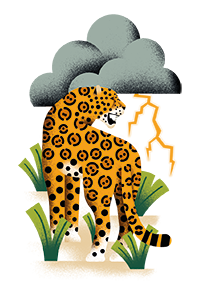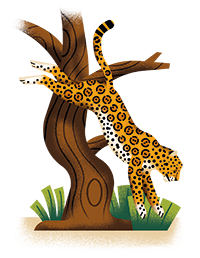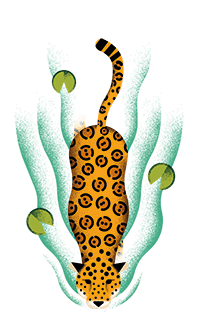Originally published in World Wildlife magazine, Fall 2021. Written by Kimberley Brown & illustrations by Daniele Simonelli.
AN AMBITIOUS INTERNATIONAL PLAN COULD BRING DECLINING JAGUAR POPULATIONS BACK
Ricardo Schwartz was excited as he awaited the big delivery. A 10-month-old Maremma sheepdog had just made the two-day, nearly 2,000-mile journey from Patagonia to Misiones Province in the northeastern tip of Argentina, transported in a blue kennel atop a truck bed by two technicians from the Instituto Nacional de Tecnología Agropecuaria (INTA). Once it arrived, the specially trained dog would have an important job to do: help a local farmer protect his sheep from a jaguar.
Together, Schwartz and the farmer had tried other methods to scare away the predator—electric fences, automatic floodlights, loud noises—but nothing had worked. Schwartz feared that if they couldn’t find a solution, the farmer would eventually kill the jaguar.
But INTA had a solution. For years, the institute has been breeding sheepdogs and training them to guard livestock against predators to help minimize conflicts between herders and pumas in Patagonia, explains Schwartz. As puppies, the dogs are raised alongside a flock of sheep and spend 24 hours a day with them, which fosters a strong bond between the animals. In time, “the dog is adopted by the sheep … and defends them as if they were family,” constantly patrolling and marking its territory. “It’s basically a sheep that barks,” he says.
Schwartz understands well the challenges farmers in Misiones face. He moved to the region with his family when he was 14 years old and has been working the same land—growing yerba mate and raising chickens, pigs, and cattle—for most of his life. Some two decades ago, he too began losing his livestock to a jaguar. Then conservationists from the Fundación Vida Silvestre Argentina (or Vida Silvestre), a WWF partner organization since 1988, approached Schwartz at a cattle fair and offered to install an electric fence around his pasture.
The fence was a game changer. In addition to successfully safeguarding his livestock, it transformed Schwartz into an unlikely evangelist for jaguar conservation; he’s been helping fellow farmers find nonlethal alternatives to human-jaguar conflict ever since. And sheepdogs, he believes, are a promising tool. If they work in Misiones as well as they have in Patagonia, he says, they could allow farmers and jaguars to share the land more peacefully.
Managing conflict between wildlife and farmers is just one way that conservationists are working to protect and increase jaguar populations in Misiones and across the Americas, where deforestation, infrastructure development, and poaching also pose increasing threats. As those pressures on jaguars and their habitats intensify, Vida Silvestre, WWF, and a growing number of organizations, governments, and civil society groups are now banding together in an unprecedented international effort to change the trajectory for this iconic big cat.
King of the forest

The Nouragues Natural Reserve’s dense tropical rain forests and riparian ecosystems provide ideal habitat for jaguars in French Guiana. © Emmanuel Rondeau/WWF-France
The jaguar, Panthera onca, is the largest feline in the Americas and has been an important mythological and cultural symbol among Indigenous communities for thousands of years. In pre-Columbian artwork, jaguars are depicted on tools, statues, and temples. The Maya associated the cat with the afterlife, believing it could move between the worlds of the living and the dead. And the Olmecs worshiped a half-jaguar/half-human deity, revering the creature for its strength and dominance over the natural world.

WATCH THOSE TEETH
Jaguars can hunt animals up to four times their weight thanks to their powerful jaws— the strongest of all cats for their size. © Daniele Simonelli/WWF-US

CAT’S MEOW
The sound of a jaguar’s roar has been compared to the sound of sawing wood and rolling thunder. © Daniele Simonelli/WWF-US
Historically, the jaguar roamed freely from Argentina to the southern US—across tropical forests, savannas, wetlands, and mountain ranges. But core populations now exist mainly in a few strongholds, including the Amazon region and the Pantanal wetland, linked by a vast mosaic of biological corridors that are vital to their survival.
Because it sits at the top of the food chain and travels so widely, the jaguar is an “umbrella species”: Conservation of the jaguar positively affects the whole ecosystem and the other species in it. “If we have healthy jaguar populations, then it’s likely that all biodiversity is healthy, because the prey and the forest have to be healthy for jaguars to survive,” says Jordi Surkin, director of conservation at WWF-Bolivia.
In a way, jaguars are an umbrella species for humans as well. Today, the jaguar’s range not only includes nearly 28% of the world’s biodiversity but provides 53 million people with ecosystem services, including freshwater, commercial fisheries, clean air, and crop pollination. In Brazil alone, it’s estimated that these environmental services generate more than US$4 billion annually.
But despite its cultural and ecological significance, the species is at risk. More than half of the jaguar’s original range has been lost, while the rest has become highly fragmented. In the last 20 years, rising global appetites for soy and beef—two of the biggest drivers of agricultural expansion in South America—have fueled a rapid, substantial clearing of the continent’s forests that has pushed jaguars into ever-smaller, isolated patches of land.
The Atlantic Forest, which encompasses Misiones and stretches from Brazil’s Atlantic coastline into Paraguay and Argentina, has been particularly hard hit. Centuries ago, the jaguar padded through the entire expanse—more than 500,000 square miles—of this vast region. But about 85% of jaguar habitat here has disappeared, and by 2016 fewer than 300 individuals occupied less than 4% of the forest; just three isolated pockets had jaguar populations larger than 50.
In Brazil and Bolivia, large-scale wildfires over the past two years have also decimated jaguar habitats and prey populations, and an increasing demand for jaguar parts—furs and fangs especially—has driven a recent surge in poaching for the illegal wildlife trade. At the same time, hunting has diminished the jaguar’s prey in some places, and as the cats turn to livestock for easy meals, they’re often killed in retaliation.
“When jaguar habitat is fragmented and people move into that habitat, then jaguars may get used to going after cattle—and also may lack other options. That’s when we start to see human-wildlife conflicts,” explains Surkin.
While it’s estimated that between 64,000 and 173,000 jaguars still exist in the wild, the numbers of jaguars and their prey are declining in most regions. Studies suggest that the species could soon qualify as Vulnerable on the International Union for Conservation of Nature’s Red List of Threatened Species. The feline has already been wiped out in Uruguay and El Salvador. And though momentum is building around a potential reintroduction of jaguars into the southern US, where large blocks of suitable habitat are available, fewer than 10 jaguars have been spotted there since 1963.
Connection and cooperation
For years, WWF and organizations such as Vida Silvestre have been working at the local level to conserve jaguars and their habitats. But most of these efforts were isolated projects—monitoring local populations or forest conservation initiatives in specific regions, for instance—and lacked the range-wide cooperation required to prevent vast tracts of territory from disappearing.
“We were losing the battle,” says conservation director María José Villanueva, who heads up WWF’s jaguar conservation work. “We realized we had to collaborate and raise our voices in a more coordinated way.”
So in 2018, WWF, the Wildlife Conservation Society, the United Nations Development Programme, wild cat conservation organization Panthera, and representatives from 14 jaguar range countries joined forces to develop the Jaguar 2030 Roadmap, an ambitious global commitment to protect the jaguar’s range from Mexico to Argentina by securing 30 priority jaguar conservation landscapes by 2030.
“If we have healthy jaguar populations, then it’s likely that all biodiversity is healthy.” – Jordi Surkin, Director of Conservation, WWF-Bolivia
Based on a shared vision, the Roadmap is about building collaborative relationships between diverse partners and across the entire span of the jaguar’s natural and potential habitat. It also goes beyond protecting the species in individual conservation sites, says Howard Quigley, executive director of conservation science and director of Panthera’s jaguar program. “The Roadmap deals with all aspects of jaguar conservation, from education to conflict issues to protecting core areas—and even the economic viability of local communities,” he says.
“When you save the jaguar … you save the water you drink, you save the air you breathe, and you save a stable climate.” – María José Villanueva, Conservation Director, WWF-Mexico
In November 2020, WWF launched its own Jaguar Regional Strategy, which aims to scale up the organization’s jaguar conservation efforts in alignment with the larger Roadmap. The strategy’s goal is to increase and stabilize jaguar populations and restore their habitat by securing jaguar strongholds, building and increasing connectivity between key landscapes, stopping jaguar killings, promoting national and international cooperation across the jaguar’s range, and advocating for public policies that recognize jaguar conservation.
Focusing on one species across several countries and landscapes also allows WWF to be more targeted in its approach.
“Let’s say we want to restore a part of a forest. We’re not going to do that just anywhere,” Surkin explains. “Instead, we’d choose a patch of forest that would help us connect two protected areas or two properties, thereby creating a valuable wildlife corridor for jaguars and other species.”
As part of its strategy, WWF has chosen 15 priority landscapes across the Americas—regions identified as ecologically important for the species—where it will strive to conserve jaguar populations and habitats through tailored, site-specific plans. In the Atlantic Forest, WWF is endeavoring to reconnect fragmented landscapes and work toward more harmonious human-jaguar coexistence. WWF is also working closely with local communities in cross-border partnerships in other jaguar pockets, like the Maya Forest and the Amazon rain forest, to ensure the jaguar’s long-term survival.

Wildfires, such as this one blazing through pastureland in Brazil, feed into the habitat fragmentation and destruction threatening jaguar populations across Latin America. © iStock.com/JoseMoraes
Progress in Argentina
In the Upper Paraná region of the Atlantic Forest, a priority landscape located mainly in Misiones, WWF’s work with Vida Silvestre provides an example of the complexities inherent in jaguar conservation and how the new strategy plays out on the ground.

WHAT’S IN A NAME?
The jaguar gets its name from the Tupí-Guaraní word yaguara, meaning “he who kills in one leap.” © Daniele Simonelli/WWF-US

SPLISH SPLASH
Unlike domestic cats, jaguars aren’t afraid of water. They regularly swim through rivers, lakes, and estuaries. © Daniele Simonelli/WWF-US
Deforestation in Misiones was once rampant. Between 1989 and 2004, the province lost 46,208 acres of forest cover per year, largely to agricultural conversion—more than double the average deforestation rates in the rest of Latin America and five times the global average. The region became a “mosaic of human activity,” says Daniela Rode, a landscape specialist with Vida Silvestre. As habitats shrank and prey disappeared, the jaguar population dropped to just 33–54 cats. “It was on the verge of collapse,” says Rode.
Then in 2003, Vida Silvestre and WWF began working together to try to stanch the jaguar’s decline. Seven years later, new government regulations were enacted to put an end to unchecked forest clearance; by 2013, deforestation rates had dropped by 70%.
But the damage had been done. After such extensive forest loss, recovering native habitats became a key component of Vida Silvestre’s work. Partnering with Argentina’s National Scientific and Technological Research Council, the organization started conducting research to identify jaguar hot spots and to determine how best to relink patches of forest by restoring deforested swaths of land. About a third of the province is made up of larger extensions of forest where jaguars can still be found, and the family farms, perennial crops, and large-scale tree farms that cover the other two-thirds represent conservation hurdles—but not barriers.
Researchers identified five critical jaguar corridors. In 2015, Vida Silvestre and partners successfully completed the first, which ultimately linked two provincial parks by connecting property buyers who wanted to invest in conservation with farmers living between the two parks who were willing to sell their properties. Now a second corridor is in the works.
That kind of cooperation between organizations, governments, and local people is vital for protecting the jaguar across its range, says Rode. And since the Jaguar 2030 Roadmap launched in 2018, Vida Silvestre has begun working more closely with other organizations to share data and resources.
Today the region’s jaguar population stands at 89–125 individuals, and Vida Silvestre is doubling down on its efforts, with more ambitious jaguar corridors, community integration initiatives, and cross-border partnerships underway with WWF offices in Brazil and Paraguay.
“If jaguars are crossing rivers, they’re crossing borders,” adds Rode. “It’s the same population, so cross-border partnerships make sense.”
The long game

Jaguars are excellent swimmers and can often be found in waterways. Here, a jaguar takes a dip in a river in the Encontro das Águas State Park in the Brazilian Pantanal. © Aline Santana Da Hora/WWF-Brazil
Eventually, says Rode, “there will be around 121,800 acres connecting three core jaguar habitats: Cruce Caballero Provincial Park, El Piñalito Provincial Park, and the Yabotí Biosphere Reserve.” Jaguars will have more room to breed and seek prey, which will bolster populations and help ensure their genetic diversity.
At the broader scale, Rode notes, WWF’s jaguar strategy will also lead to more funding and cooperation in the region, which will propel important projects such as these corridors forward. “Now we can do many more things in more places with more people, and get closer to what we have planned,” she says.
Surkin, Villanueva, and others agree that jaguar conservation and large landscape protections won’t happen overnight, and will require continued coordination across countries and collaboration among a variety of actors.
But it will have been worth it.
“When you save the jaguar, you save much more,” says Villanueva. “You save the water you drink, you save the air you breathe, and you save a stable climate.”
Back in Misiones, Schwartz says the provincial government is now considering creating local breeding centers after witnessing Maremma sheepdogs in action. He also says that he is invested in jaguar conservation work for the long haul.
“I’ve seen people who care about saving these animals while helping farmers continue with their production. That seems good to me,” he says. “I think I’ll keep doing this.”



























